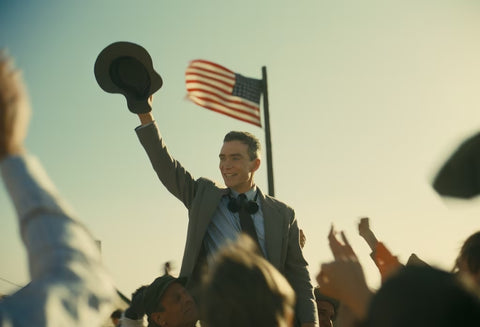
‘Oppenheimer’ is A Chilling Look At Mankind’s Capacity For Destruction
(Warning: Spoilers ahead)
World War II ended with a literal bang when the U.S. military leveled the Japanese cities of Hiroshima and Nagasaki with never-before-seen atomic devastation. And though the explosive events of Aug. 6 and 9, 1945 live on as an ominous warning of the power of nuclear weapons, the series of events preceding those days have been relatively glossed over in the world of modern cinema — until now.
Christopher Nolan’s (”Dark Knight,” “Dunkirk”) “Oppenheimer” is a war epic, a revelation, and a cinematic masterpiece, but above all, it is a horror film. The sense of foreboding created while witnessing the best of humanity careen toward its own demise elicits a sense of dread more reminiscent of the best of the horror genre.
Loosely based on the biography “American Prometheus: The Triumph and Tragedy of J. Robert Oppenheimer,” Nolan’s story of J. Robert Oppenheimer — the father of the atomic bomb — is both beautiful and terrifying.
Played by Cillian Murphy at his absolute best, Oppenheimer offers a portrait of the individual struggle between balancing the pursuit of greatness and bringing humanity the closest it has ever been to its own destruction.
Nolan, at the top of his game for his second World War II film (following the triumphant “Dunkirk”), hurls movie-goers into Oppenheimer’s life in an almost schizophrenic manner, jumping through time and incorporating black-and-white sequences to illustrate the frenzied lead up to those fateful days in 1945.
As an individual, Oppenheimer explores the moral conflicts of religion, politics, and philosophy that weigh heavily on his involvement in the infamous Manhattan Project, a decision he makes with a blend of hubris and scientific curiosity.
In the grand scheme, Oppenheimer’s decision to build the bomb is one he believes to be for the good of mankind. Exhibiting to the world this kind of destructive power, he naively thinks, will mean the end of all wars. In reality, the new technology threw the world into an arms race during the ensuing Cold War, the traces of which are still seen today as countries around the globe attempt to develop their own nuclear arsenals.
While viewers might expect the bombing events on August 6 and 9 to be the height of the film, the real climax arrives as the team prepares to drop a test explosive south of Los Alamos, New Mexico. The event marks the culmination of years of work conducted by the world’s smartest minds. And as the device is lowered for detonation, the pent-up fear that preceded it is unleashed in a firework display of destruction.
As the countdown hits zero, there is a flash and silence. A mushroom cloud pillows into the night sky. The feeling of victory for the team is immediate, but for the audience, there is a feeling more akin to the climax of a horror film in which the lead character realizes death is imminent.
“Now I am become Death, the destroyer of worlds,” Oppenheimer’s voice echoes over the aftershocks of the bomb. The quote from the Bhagavad Gita makes numerous appearances in the film, and though it’s a bit on the nose, it encapsulates what the physicist becomes in his quest for knowledge.
The sentiment that follows throughout the rest of the movie, to hearken back to Jurassic Park, is one of Manhattan Project personnel being so preoccupied with whether or not they could create an atomic bomb, that no one stops to consider whether they should.
The original impetus of nuclear development in the U.S. may have been to beat the Nazis to constructing the bomb, but once America’s nuclear program began — even with the Germans surrendering — there was no stopping it.
And Oppenheimer, once seen as an American patriot who brought about a heroic end to the war, must live with the realization that he may, in fact, be the greatest villain in human history.
“Oppenheimer” is in theaters July 21.
Originally published by Military Times, our sister publication.
